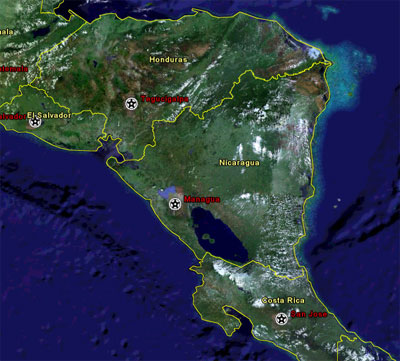EL SALVADOR
Please note, this page is not longer being updated. For more recent information, please see news.mongabay.com and use the search function to find the country feed. For more up-to-date data on forest cover and loss, check out Global Forest Watch.
| El Salvador Forest Figures
Forest Cover Total forest area: 298,000 ha % of land area: 14.4% Primary forest cover: 6,000 ha % of land area: 0.3% % total forest area: 2.0% Deforestation Rates, 2000-2005 Annual change in forest cover: -5,200 ha Annual deforestation rate: -1.7% Change in defor. rate since '90s: 18.0% Total forest loss since 1990: -77,000 ha Total forest loss since 1990:-20.5% Primary or "Old-growth" forests Annual loss of primary forests: n/a Annual deforestation rate: n/a Change in deforestation rate since '90s: n/a Primary forest loss since 1990: n/a Primary forest loss since 1990:0.0% Forest Classification Public: 72.5% Private: 25.3% Other: 2.2% Use Production: 2% Protection: n/a Conservation: 2.3% Social services: n/a Multiple purpose: n/a None or unknown: 95.6 Forest Area Breakdown Total area: 298,000 ha Primary: 6,000 ha Modified natural: 286,000 ha Semi-natural: n/a Production plantation: 6,000 ha Production plantation: n/a Plantations Plantations, 2005: 6,000 ha % of total forest cover: 2% Annual change rate (00-05): n/a Carbon storage Above-ground biomass: n/a M t Below-ground biomass: n/a M t Area annually affected by Fire: 1,000 ha Insects: n/a Diseases: n/a Number of tree species in IUCN red list Number of native tree species: n/a Critically endangered: 1 Endangered: 6 Vulnerable: 19 Wood removal 2005 Industrial roundwood: 682,000 m3 o.b. Wood fuel: 4,519,000 m3 o.b. Value of forest products, 2005 Industrial roundwood: n/a Wood fuel: n/a Non-wood forest products (NWFPs): n/a Total Value: n/a More forest statistics for El Salvador |
Deforestation in El Salvador has had serious environmental, social, and economic impacts. Today over 50 percent of El Salvador is not even suitable for food cultivation, and much of the country is plagued with severe soil erosion. Denuded hillsides leave the country vulnerable to devastating mudslides—in October 2005, landslides resulting from a series of storms killed more than 50 and required the evacuation of more than 34,000 residents. Degraded forest areas are more susceptible to fires—in 1998 fires caused more than $172 million in damage to forests and agricultural plots.
Today most deforestation in El Salvador results from the country's high population that relies heavily on the collection of fuelwood and subsistence hunting and agriculture. Although the government has protected areas of forest, forestry laws go unenforced due to lack of funds and management.
In total, El Salvador lost 20.5 percent of its forest cover between 1990 and 2005. The country's deforestation rate has increased by 18 percent since the close of the 1990s.
Recent articles | El Salvador news updates | XML
Suggested reading - Books
- A Field Guide to the Birds of Mexico and Adjacent Areas : Belize, Guatemala, and El Salvador, Third Edition
- El Salvador Map
- Lonely Planet Central America on a Shoestring
- A Field Guide to Mexican Birds : Mexico, Guatemala, Belize, El Salvador
- A Field Guide to the Mammals of Central America and Southeast Mexico
Unless otherwise specified, this article was written by Rhett A. Butler [Bibliographic citation for this page]
Other resources
Contact me if you have suggestions on other rainforest-related environmental sites and resources for this country.

Image copyright Google Earth, MDA EarthSet, DigitalGlobe 2005
CIA-World Factbook Profile
FAO-Forestry Profile
Last updated: 6 Feb 2006
